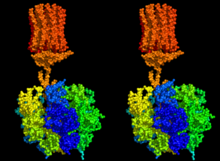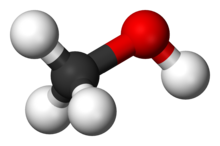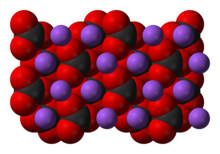


A chemical compound is a complex substance consisting of chemically bonded atoms of two or more elements (heteronuclear molecules). Some simple substances can also be considered as chemical compounds if their molecules consist of atoms connected by a covalent bond ( nitrogen , oxygen , iodine , bromine , chlorine , fluorine , presumably astatine ) [2] . Inert (noble) gases and atomic hydrogen cannot be considered chemical compounds.
History
For the formulation of the concept of a chemical compound, the law of constancy of composition , discovered by Joseph Proust in 1799, was important [3] . This law states that regardless of how a particular compound was obtained, it always consists of the same chemical elements, and the mass ratio of these elements is expressed in small integers. A few years later, in 1803 , John Dalton formulated the law of multiple relations , according to which in the case when two compounds can form from certain elements, such masses of the other are combined with a certain mass of the first one that their ratio also gives an integer [4] [ 5] [6] . These two statements prepared the way to understanding the atomic structure of matter.
The concept of a structural formula was introduced in the 1850s by the German chemist Friedrich August Kekule von Stradonitz [7] [8] .
Qualitative and quantitative composition
The composition of a chemical compound is written in the form of chemical formulas , and the structure is often depicted by structural formulas . The systematic name ( IUPAC nomenclature ) also indicates the composition of the compound.
In the vast majority of cases, chemical compounds obey the law of constancy of composition and the law of multiple ratios . However, quite numerous compounds of variable composition ( bertollides ) are known, for example:
- Pa O 2.18 —PaO 2.21 .
To establish the qualitative and quantitative composition of a chemical compound, various methods of chemical analysis are used (for example, colorimetry , chromatography ). These methods are the subject of study of analytical chemistry .
Differences between compounds and mixtures
The physical and chemical properties of the compounds differ from the properties of a mixture of simple substances - this is one of the main criteria for distinguishing a compound from mixtures of simple or complex substances, since the properties of a mixture are usually closely related to the properties of the components. Another criterion for the difference is that the mixture can usually be separated into components by non-chemical processes, such as sieving, filtration, evaporation, use of magnets, while the components of a chemical compound can only be separated using a chemical reaction. Conversely, mixtures can be created without using a chemical reaction, but no compounds.
Some mixtures are so closely related that some of their properties are similar to those of chemical compounds, and they are easy to confuse. The most common examples of such mixtures are alloys . Alloys are made using physical processes, usually by melting and mixing the components, followed by cooling.
An example of chemical compounds that are similar in properties but are neither alloys nor mixtures are intermetallic compounds .
Chemical Reactions
Chemical compounds are obtained as a result of chemical reactions . Complex substances can decompose to form several other substances. The formation of chemical compounds is accompanied by the release ( exothermic reaction ) or absorption ( endothermic reaction ) of energy. The physical and chemical properties of chemical compounds differ from the properties of the substances from which they are derived. Chemical compounds are divided into inorganic and organic . More than 100 thousand inorganic and more than 3 million organic compounds are known. Each chemical compound described in the literature has a unique identifier - a CAS number .
Chemical classes
Chemical compounds are divided into classes: inorganic and organic . The latter in a broad sense include organoelement compounds : organoboron , organosilicon , organophosphorus , etc.
Some types of complex inorganic compounds:
- oxides ( H 2 O , CaO , CO 2 , P 2 O 5 (P 4 O 10 ), etc.)
- hydroxides :
- bases ( Na (OH) , Ca (OH) 2 , etc.)
- oxygen-containing acids ( HNO 3 , H 2 SO 4 , H 3 PO 4 , etc.)
- amphoteric hydroxides ( Al (OH) 3 , Fe (OH) 3 , etc.)
- oxygen-free acids ( HCl , HCN , etc.)
- nitrides ( NH 3 , Si 3 N 4 , etc.)
- salts ( NaCl , KNO 3 , Fe 2 (SO 4 ) 3 , LiBr , etc.)
- crystalline hydrates : ( CuSO 4 · 5H 2 O and others)
- complex compounds : ( K 3 [Fe (CN) 6 ] , etc.)
Organic matter
Organic compounds, organic substances - a class of chemical compounds that include carbon (excluding carbides , carbonic acid , carbonates , carbon oxides and cyanides ). [9]
Inorganic Substances
An inorganic substance or inorganic compound is a chemical compound that is not organic , that is, it does not contain carbon (except carbides , cyanides , carbonates , carbon oxides and some other compounds that are traditionally referred to as inorganic ). Inorganic compounds do not have a carbon skeleton characteristic of organic.
Description of the main groups of organic compounds
Hydrocarbons
Organic compounds consisting exclusively of carbon and hydrogen atoms . Hydrocarbons are considered basic compounds of organic chemistry, all other organic compounds are considered as their derivatives. Since carbon has four valence electrons and hydrogen has one, the simplest hydrocarbon is methane (CH 4 ). In the systematization of hydrocarbons, the structure of the carbon skeleton and the type of bonds connecting the carbon atoms are taken into account. Depending on the topology of the structure of the carbon skeleton, hydrocarbons are divided into acyclic and carbocyclic . Depending on the multiplicity of carbon-carbon bonds, hydrocarbons are divided into limiting ( alkanes ) and unsaturated ( alkenes , alkynes , dienes ). Cyclic hydrocarbons are divided into alicyclic and aromatic .
Alcohols
organic compounds containing one or more hydroxyl groups (hydroxyl, - O H ) directly associated with a saturated (in the state of sp ³ hybridization ) carbon atom [10] . Alcohols can be considered as derivatives of water ( H − O − H ) , in which one hydrogen atom is replaced by an organic functional group : R − O − H. In the IUPAC nomenclature, for compounds in which the hydroxyl group is bonded to an unsaturated ( sp ² hybrid ) carbon atom, the names “ enols ” (hydroxyl bonded to vinyl C = C bond) [11] and “ phenols ” (hydroxyl bonded to benzene ) are recommended or other aromatic cycle) [12] . Alcohols represent an extensive and diverse class of compounds: they are very common in nature and often perform important functions in living organisms. Alcohols are important compounds from the point of view of organic synthesis , not only of interest as target products, but also as intermediates with a number of unique chemical properties. In addition, alcohols are industrially important products and are widely used both in industry and in everyday applications.
Ethers
Ethers are organic substances having the formula R — O — R 1 , where R and R 1 are hydrocarbon radicals . However, it should be borne in mind that such a group can be part of other functional groups of compounds that are not ethers (see Oxygen-containing organic compounds ).
Esters are derivatives of oxoacids (both carboxylic and mineral ) R k E (= O) l (OH) m , (l ≠ 0), which are formally the products of the replacement of hydrogen atoms of hydroxyls — OH acid function with a hydrocarbon residue (aliphatic, alkenyl aromatic or heteroaromatic); are also considered as acyl derivatives of alcohols . In the IUPAC nomenclature, esters also include acyl derivatives of chalcogenide analogs of alcohols ( thiols , selenols, and tellurols) [13] . They differ from ethers in which two hydrocarbon radicals are connected by an oxygen atom (R 1 –O – R 2 ).
Aldehydes
A class of organic compounds containing a carbonyl group (C = O) with one alkyl or aryl substituent. Aldehydes and ketones are very similar, the difference is that the latter have two substituents on the carbonyl group . The polarization of the carbon-oxygen double bond by the principle of mesomeric conjugation allows us to record the following resonant structures : . Such a separation of charges is confirmed by physical research methods and largely determines the reactivity of aldehydes as expressed electrophiles . In general, the chemical properties of aldehydes are similar to ketones , however, aldehydes are more active, which is associated with a higher polarization of the bond. In addition, aldehydes are characterized by reactions that are not characteristic of ketones, for example, hydration in an aqueous solution: in methanal , due to even greater polarization, the bond is complete, and in other aldehydes, it is partial: . The simplest aldehydes have a sharp characteristic odor (for example, benzaldehyde - the smell of almonds ). Under the action of hydroxylamine, they turn into oximes : .
Ketones
Organic substances in the molecules of which the carbonyl group is bound to two hydrocarbon radicals. General formula of ketones: R 1 -CO-R 2 . Among other carbonyl compounds, the presence in ketones of precisely two carbon atoms directly bonded to the carbonyl group distinguishes them from carboxylic acids and their derivatives, as well as aldehydes .
Carboxylic Acids
A class of organic compounds whose molecules contain one or more functional carboxyl groups —COOH. Acidic properties are explained by the fact that this group can relatively easily cleave the proton . With few exceptions, carboxylic acids are weak. For example, in acetic acid CH 3 COOH, the acidity constant is 1.75⋅10 −5 . Di- and tricarboxylic acids are stronger than monocarboxylic.
Amides
Derivatives of oxoacids (both carboxylic and mineral ) R k E (= O) l (OH) m , (l ≠ 0), which are formally products of substitution of the hydroxyl groups of- OH acid function by an amino group (unsubstituted and substituted); are also considered as acyl derivatives of amines . Compounds with one, two or three acyl substituents at the nitrogen atom are called primary, secondary and tertiary amides, secondary amides are also called imides . Carboxylic acid amides - carboxamides RCO – NR 1 R 2 (where R 1 and R 2 are hydrogen, acyl or an alkyl, aryl or other hydrocarbon radical) are usually referred to as amides, in the case of other acids in accordance with IUPAC guidelines when naming the amide as a prefix the name of the acid residue is indicated, for example, sulfide acid amides RS (= O 2 NH 2 are called sulfamides . Amide analogs, formally products of the substitution of oxygen for chalcogen , are called thioamides , selenoamides and tellurium amides [14] .
Amines
Organic compounds that are derivatives of ammonia , in the molecule of which one, two or three hydrogen atoms are replaced by hydrocarbon radicals . By the number of substituted hydrogen atoms, primary and secondary (replaced by one hydrogen atom), secondary (replaced by two hydrogen atoms from three) and tertiary (replaced by three hydrogen atoms from three) amines, respectively, are distinguished. The quaternary ammonium compound of the form [R 4 N ] + Cl - is an organic analogue of the ammonium salt . Aliphatic C H 3 - N <, aromatic C 6 H 5 - N <, and aromatic fatty (containing aromatic and aliphatic radicals) amines are distinguished by the nature of the organic group associated with nitrogen. By the number of NH 2 groups in the molecule, amines are divided into monoamines, diamines, three amines, and so on.
CAS Registration Number
All chemicals, and therefore all chemical compounds described in the scientific literature, are assigned the number of CAS , the chemical abstract service, by which the substance can be identified in databases, for example, PubChem .
Literature
- Robert Siegfried. From elements to atoms: a history of chemical composition. - American Philosophical Society, 2002. - ISBN 978-0-87169-924-4 .
- Silberberg, Martin. Chemistry: The Molecular Nature Of Matter and Change. New York: McGraw-Hill Companies, 2004. ISBN 0-07-310169-9
- Alcohols // Brockhaus and Efron Encyclopedic Dictionary : in 86 volumes (82 volumes and 4 additional). - SPb. , 1890-1907.
- Higher fatty alcohols (applications, production methods, physicochemical properties) / Edited by S. M. Loktev. - M .: "Chemistry", 1970. - 329 p.
- Kurtz A.L., Brusova G.P., Demyanovich V.M. Monohydroxy and dihydric alcohols, ethers and their sulfur analogues . Educational materials. Organic Chemistry . ChemNet. Faculty of Chemistry, Moscow State University (1999). Date of treatment July 10, 2010. Archived August 21, 2011.
- Markizova N.F., Grebenyuk A.N., Basharin V.A., Bonitenko E. Yu. Alcohols. - SPb. : “The Tome”, 2004. - 112 p. - (Toxicology for doctors). - ISBN 5-93929-089-2 .
- Reutov O.A., Kurtz A.L., Butin K.P. Organic chemistry. - 3rd ed .. - M: Binom. Laboratory of Knowledge, 2010. - T. 2. - ISBN 978-5-94774-614-9 .
- Alcohols . Encyclopedia of labor protection and safety. Volume IV Section XVIII. Reference books. Overview of chemical compounds . Institute of Industrial Safety, Labor Protection and Social Partnership. Date of treatment December 27, 2010. Archived August 21, 2011.
- Chemistry. Reference guide. Per. with him. L., Chemistry 1975, ss. 240-242.
- Chemical Encyclopedia in 5 volumes. ed. I.L. Knunyants. 5 volume
- Aldehyde // Brockhaus and Efron Encyclopedic Dictionary : in 86 volumes (82 volumes and 4 additional). - SPb. , 1890-1907.
- Knunyants I.L. et al. 1 A-Darzan // Chemical Encyclopedia. - M .: Soviet Encyclopedia, 1988 .-- 623 p. - 100,000 copies.
- Sykes P. Mechanisms of reactions in organic chemistry. M .: Chemistry. 1991
- Adams M. Carboxylic Acids in Organics. M .: Chemistry. 1990
- J. Robert, M. Caserio "Fundamentals of Organic Chemistry" vol. 1 Edition 2, supplemented. 1978
- Амиды // Энциклопедический словарь Брокгауза и Ефрона : в 86 т. (82 т. и 4 доп.). - SPb. , 1890-1907.
- Кнунянц И. Л. и др. т.1 А-Дарзана // Химическая энциклопедия. — М. : Советская энциклопедия, 1988. — 623 с. - 100,000 copies.
See also
- Простые вещества
Notes
- ↑ см. Метод параллельного взгляда
- ↑ Соединение химическое — статья из Большой советской энциклопедии .
- ↑ Proust, J.-L. (1799). Researches on copper, Ann. chim. , 32 :26-54. Excerpt , in Henry M. Leicester and Herbert S. Klickstein, A Source Book in Chemistry, 1400—1900 , Cambridge, MA: Harvard, 1952. Accessed 2008-05-08.
- ↑ Helmenstine, Anne Law of Multiple Proportions Problem . 1 . Дата обращения 31 января 2012. Архивировано 8 декабря 2012 года.
- ↑ law of multiple proportions definition
- ↑ law of multiple proportions (chemistry) (англ.) . — статья из Encyclopædia Britannica Online .
- ↑ Aug. Kekulé. Über die sg gepaarten Verbindungen und die Theorie der mehratomigen Radicale (нем.) // Annalen der Chemie und Pharmacie : magazin. — 1857. — Bd. 104 , Nr. 2 . — S. 129—150 . — DOI : 10.1002/jlac.18571040202 .
- ↑ Aug. Kekulé. Ueber die Constitution und die Metamorphosen der chemischen Verbindungen und über die chemische Natur des Kohlenstoffs (нем.) // Annalen der Chemie und Pharmacie : magazin. — 1858. — Bd. 106 , Nr. 2 . — S. 129—159 . — DOI : 10.1002/jlac.18581060202 .
- ↑ Хомченко Г. П. Пособие по химии для поступающих в вузы. - 3rd ed. испр. and add. — М.: ООО «Издательство Новая Волна», ЗАО «Издательский Дом ОНИКС», 2000. с. 334. ISBN 5-7864-0103-0 , ISBN 5-249-00264-1
- ↑ Alcohols (англ.) . IUPAC. Compendium of Chemical Terminology, 2nd ed. (the "Gold Book"). doi : 10.1351/goldbook.A00204 . Дата обращения 2 сентября 2010. Архивировано 21 августа 2011 года.
- ↑ Enols (англ.) . IUPAC. Compendium of Chemical Terminology, 2nd ed. (the «Gold Book»). doi : 10.1351/goldbook.E02124 . Дата обращения 2 сентября 2010. Архивировано 21 августа 2011 года.
- ↑ Phenols (англ.) . IUPAC. Compendium of Chemical Terminology, 2nd ed. (the «Gold Book»). doi : 10.1351/goldbook.P04539 . Дата обращения 2 сентября 2010. Архивировано 21 августа 2011 года.
- ↑ esters // IUPAG Gold Book
- ↑ amides // IUPAC Gold Book